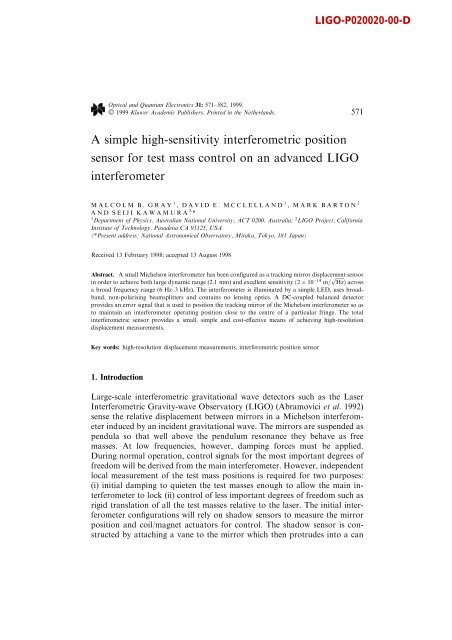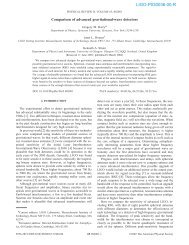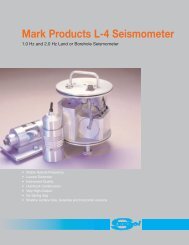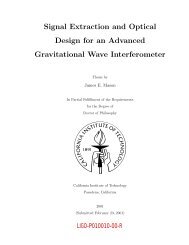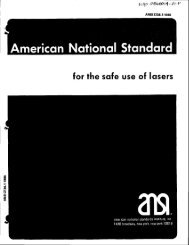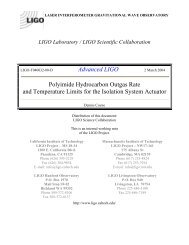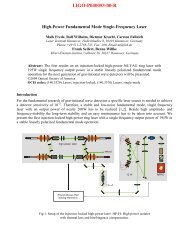A simple high-sensitivity interferometric position sensor for - LIGO ...
A simple high-sensitivity interferometric position sensor for - LIGO ...
A simple high-sensitivity interferometric position sensor for - LIGO ...
You also want an ePaper? Increase the reach of your titles
YUMPU automatically turns print PDFs into web optimized ePapers that Google loves.
A <strong>simple</strong> <strong>high</strong>-<strong>sensitivity</strong> <strong>interferometric</strong> <strong>position</strong><br />
<strong>sensor</strong> <strong>for</strong> test mass control on an advanced <strong>LIGO</strong><br />
interferometer<br />
MALCOLM B. GRAY 1 , DAVID E. MCCLELLAND 1 , MARK BARTON 2<br />
AND SEIJI KAWAMURA 2, *<br />
1 Department of Physics, Australian National University, ACT 0200, Australia; 2 <strong>LIGO</strong> Project, Cali<strong>for</strong>nia<br />
Institute of Technology, Pasadena CA 91125, USA<br />
(*Present address: National Astronomical Observatory, Mitaka, Tokyo, 181 Japan)<br />
Received 13 February 1998; accepted 13 August 1998<br />
Abstract. A small Michelson interferometer has been con®gured as a tracking mirror displacement <strong>sensor</strong><br />
in order to achieve both large dynamic range (2.1 mm) and excellent <strong>sensitivity</strong> …2 10 14 p<br />
m= Hz†<br />
across<br />
a broad frequency range (6 Hz±3 kHz). The interferometer is illuminated by a <strong>simple</strong> LED, uses broadband,<br />
non-polarising beamsplitters and contains no lensing optics. A DC-coupled balanced detector<br />
provides an error signal that is used to <strong>position</strong> the tracking mirror of the Michelson interferometer so as<br />
to maintain an interferometer operating <strong>position</strong> close to the centre of a particular fringe. The total<br />
<strong>interferometric</strong> <strong>sensor</strong> provides a small, <strong>simple</strong> and cost-e€ective means of achieving <strong>high</strong>-resolution<br />
displacement measurements.<br />
Key words: <strong>high</strong>-resolution displacement measurements, <strong>interferometric</strong> <strong>position</strong> <strong>sensor</strong><br />
1. Introduction<br />
<strong>LIGO</strong>-P020020-00-D<br />
Optical and Quantum Electronics 31: 571±582, 1999.<br />
Ó 1999 Kluwer Academic Publishers. Printed in the Netherlands. 571<br />
Large-scale <strong>interferometric</strong> gravitational wave detectors such as the Laser<br />
Interferometric Gravity-wave Observatory (<strong>LIGO</strong>) (Abramovici et al. 1992)<br />
sense the relative displacement between mirrors in a Michelson interferometer<br />
induced by an incident gravitational wave. The mirrors are suspended as<br />
pendula so that well above the pendulum resonance they behave as free<br />
masses. At low frequencies, however, damping <strong>for</strong>ces must be applied.<br />
During normal operation, control signals <strong>for</strong> the most important degrees of<br />
freedom will be derived from the main interferometer. However, independent<br />
local measurement of the test mass <strong>position</strong>s is required <strong>for</strong> two purposes:<br />
(i) initial damping to quieten the test masses enough to allow the main interferometer<br />
to lock (ii) control of less important degrees of freedom such as<br />
rigid translation of all the test masses relative to the laser. The initial interferometer<br />
con®gurations will rely on shadow <strong>sensor</strong>s to measure the mirror<br />
<strong>position</strong> and coil/magnet actuators <strong>for</strong> control. The shadow <strong>sensor</strong> is constructed<br />
by attaching a vane to the mirror which then protrudes into a can
572 M. B. GRAY ET AL.<br />
holding an LED and a photodiode. As the mirror moves, the vane obstructs<br />
the LED beam resulting in a change in the detector output. The displacement<br />
noise per<strong>for</strong>mance of these shadow <strong>sensor</strong>s has been measured at<br />
10 10 p<br />
m= Hz at frequencies above 10 Hz. By using a 10 pole Chebyschev<br />
Type I low-pass ®lter (corner frequency of 12 Hz), this shadow <strong>sensor</strong> noise<br />
can be attenuated to 5 10 20 p<br />
m= Hz at 40 Hz (the start of the <strong>LIGO</strong> signal<br />
band). While this is considered adequate <strong>for</strong> the initial <strong>LIGO</strong> interferometer,<br />
advanced interferometers will require better <strong>sensitivity</strong> at much lower frequencies<br />
(the bottom of the signal band is expected to be pushed down to<br />
10 Hz or less). The resulting shadow <strong>sensor</strong> noise source, in addition to a<br />
number of other noise sources, must there<strong>for</strong>e be reduced <strong>for</strong> advanced<br />
interferometers. One obvious means of reducing the equivalent displacement<br />
noise of the suspended test mass local readout system is to use a small<br />
<strong>interferometric</strong> <strong>sensor</strong> to replace the shadow <strong>sensor</strong> currently used. This<br />
paper reports on the work per<strong>for</strong>med to build such a <strong>sensor</strong> suitable <strong>for</strong><br />
accurate <strong>position</strong> sensing of suspended test masses.<br />
In this paper, we ®rst describe the merits of an <strong>interferometric</strong> <strong>sensor</strong> and<br />
brie¯y compare this approach with several competing con®gurations. We<br />
describe the basic <strong>interferometric</strong> <strong>sensor</strong> design and justify our approach. The<br />
per<strong>for</strong>mance of the resulting <strong>sensor</strong>, in both bench top and vacuum tests, is<br />
then presented. Finally, a few potential alternative applications <strong>for</strong> this<br />
<strong>sensor</strong> are brie¯y discussed be<strong>for</strong>e our concluding remarks.<br />
2. Sensor comparison<br />
For a shot noise-limited Michelson interferometer with a fringe height of If<br />
Amps, a displacement p Dz produces a photocurrent of 4 IfDz=k, while the shot<br />
noise is given by …2eIf† . For a wavelength of k ˆ 880 nm, a photodetector<br />
responsivity of 0.5 A/W and an incident power of 10 mW, the shot noise<br />
equivalent displacement gives a <strong>sensitivity</strong> of 2 10 15 p<br />
m= Hz (Stevenson<br />
et al. 1993). Such an interferometer would typically have an unambiguous<br />
dynamic range limited to approximately half a fringe (220 nm <strong>for</strong> an 880 nm<br />
light source Michelson interferometer). In order to increase this range, one<br />
mirror of the <strong>sensor</strong> interferometer can be made to track the displacement of<br />
the other (the test mass mirror). This closed loop tracking interferometer can<br />
then have a dynamic range limited only by the actuator used to <strong>position</strong> the<br />
tracking mirror. In practice, this implies a dynamic range of not more than<br />
around nine orders of magnitude (Apex Microtechnology Corporation).<br />
There<strong>for</strong>e, if we design <strong>for</strong> a shot noise-limited <strong>sensitivity</strong> of 10 14 p<br />
m= Hz,<br />
the dynamic range can be up to 10 5 m.<br />
Another potentially useful feature of an <strong>interferometric</strong> <strong>sensor</strong> is the ability<br />
to measure a suspended test mass without the need to a x anything directly
<strong>LIGO</strong> INTERFEROMETER 573<br />
to the mass itself (other than a <strong>high</strong> re¯ective coating). This may prove<br />
necessary in order to achieve the extremely <strong>high</strong> mechanical Qs required to<br />
suppress thermal noise (Gillespie and Raab 1993). Currently, the design relies<br />
on a small permanent magnet glued directly to the test mass which both acts<br />
as the vane <strong>for</strong> the shadow <strong>sensor</strong> and allows magnetic <strong>for</strong>ce to be applied via<br />
the coil. Using a stando€ with a narrow waist reduces the Q degradation to a<br />
level acceptable <strong>for</strong> initial <strong>LIGO</strong>, but <strong>for</strong> <strong>high</strong>er-<strong>sensitivity</strong> detectors a<br />
completely non-contacting <strong>sensor</strong>/actuator system will be required.<br />
A number of alternative <strong>sensor</strong>s can be proposed to per<strong>for</strong>m the task of<br />
test mass location. These include astigmatism-based <strong>sensor</strong>s, long coherence<br />
length <strong>interferometric</strong> <strong>sensor</strong>s and variations on the existing shadow <strong>sensor</strong>.<br />
All of these devices can potentially be con®gured to achieve sensitivities<br />
approaching 10 15 p<br />
m= Hz but this invariably limits the dynamic range to<br />
values approaching 200 nm. In order to expand the dynamic range, it is then<br />
necessary to use a tracking servo <strong>sensor</strong> to <strong>for</strong>ce the <strong>sensor</strong> to operate around<br />
the centre of the e€ective fringe. The question of which <strong>sensor</strong> to use is then<br />
decided on the ease of implementation and the cost of the components, rather<br />
than the potential per<strong>for</strong>mance.<br />
The short coherence length <strong>interferometric</strong> <strong>sensor</strong> proposed here has excellent<br />
<strong>sensitivity</strong> and dynamic range, and is also non-invasive, <strong>simple</strong> and<br />
inexpensive ± a combination very di cult to achieve with other <strong>sensor</strong> con-<br />
®gurations.<br />
3. Design justi®cation<br />
3.1. OVERVIEW<br />
A simpli®ed schematic representation of the <strong>sensor</strong> is shown in Fig. 1.<br />
A <strong>simple</strong> Michelson interferometer con®guration is used. Detectors are<br />
placed at both Michelson outputs. The two detector outputs are di€erenced,<br />
after correcting <strong>for</strong> the factor of two di€erence in intensity, to provide an<br />
error signal <strong>for</strong> the <strong>high</strong>-voltage ampli®er used to <strong>position</strong> the tracking<br />
mirror via a PZT actuator. This closed loop operation, with a large loop gain<br />
and small subsequent residual error, ensures that the interferometer is held<br />
close to the centre of a fringe (half maximum intensity at both interferometer<br />
outputs). The di€erenced output also serves as the signal readout.<br />
3.2. LED<br />
In order to ensure that the <strong>sensor</strong> was <strong>simple</strong>, compact and inexpensive, a<br />
<strong>high</strong>-e ciency LED was chosen as the light source. While the emission
574 M. B. GRAY ET AL.<br />
Fig. 1. Schematic representation of the <strong>interferometric</strong> <strong>sensor</strong>.<br />
bandwidth of the LED … 30 nm† was broad and the coherence length was<br />
consequently short … 20 lm†, there was no need <strong>for</strong> the temperature stabilisation<br />
and feedback isolation that a diode laser-based <strong>sensor</strong> would require.<br />
In addition, the LED output could readily achieve shot noise-limited intensity<br />
noise at frequencies down to 1 kHz. This is extremely di cult to<br />
achieve with diode lasers as they typically exhibit complex multimode noise<br />
behaviour (Inoue et al. 1997). The <strong>high</strong>est e ciency LED with a useful<br />
collimated radiation pattern was selected: the Hitachi HE8807FL. This device<br />
provides 10 mW output power (<strong>for</strong> a drive current of 100 mA) centred<br />
at 880 nm with a radiation full-width angle of 8 degrees. The LED was<br />
driven by a <strong>simple</strong> feedback circuit in order to stabilise the drive current.<br />
3.3. DETECTOR CIRCUIT<br />
A low frequency balanced detector circuit was developed to sense the interferometer<br />
output. The subtracter circuit included a di€erential gain of 2 in<br />
order to compensate <strong>for</strong> the fact that the symmetric detector receives half the<br />
light that the antisymmetric detector does. The 3 dB frequency response was
<strong>LIGO</strong> INTERFEROMETER 575<br />
chosen to be approximately 30 kHz, well above the unity gain frequency of<br />
the <strong>sensor</strong> … 3 kHz†.<br />
3.4. OPTICAL GEOMETRY AND MECHANICAL LAYOUT<br />
In order to achieve a good fringe visibility …V 0:9†, it was necessary to<br />
aperture the LED. This was achieved by placing a 2 mm aperture (active<br />
emission diameter of LED = 5 mm) approximately 5 mm in front of the<br />
LED. The LED contains a plastic lens at the top of the can. This produces<br />
an output that is nominally collimated. As the LED has a large active area,<br />
the output can be considered to be a family of collimated rays each at a<br />
di€erent angle. The aperture then selects a subset of the angular distribution<br />
of rays in order to keep the divergence small. As the active area of the<br />
photodiodes was su ciently large … 15 mm 2 †, there was no need <strong>for</strong> subsequent<br />
lenses.<br />
3.5. TRACKING MIRROR AND HV AMP<br />
The tracking mirror used was a 1=2 00 Newport mirror (05D20ER.2). This was<br />
glued onto a PZT actuator (Litz Picklemann 500/15-8/5 Ringactuator). The<br />
PZT chosen had a dynamic range of +5 and 1 lm <strong>for</strong> input voltages of<br />
+500 and 100 V. A low-noise, <strong>high</strong>-voltage ampli®er (‡200 to 80 V<br />
range) based on an Apex PA85 <strong>high</strong>-voltage Op-Amp (Apex Microtechnology<br />
Corporation) was designed to drive this actuator. The ampli®er had a<br />
dynamic range approaching nine orders of magnitude.<br />
3.6. CONTROL SYSTEM DESIGN<br />
The closed loop bandwidth of the complete servo was determined by a <strong>simple</strong><br />
1 pole servo ®lter (pole at 25 Hz) immediately after the balanced photodetector<br />
(see Fig. 1). As all other components had essentially frequency-independent<br />
response relative to the servo ®lter (e.g., the fundamental resonance<br />
of the PZT actuator is 30 kHz), the open loop gain was simply an amplitude-scaled<br />
version of the frequency response of the servo ®lter alone. By<br />
selecting the signal output point to be after the servo ®lter, the signal output<br />
was frequency independent <strong>for</strong> frequencies where the open loop gain was<br />
large (less than 1 kHz). At frequencies near or above the unity gain frequency,<br />
this design gave a frequency response that rolled o€ at (1/f) and<br />
avoided signi®cant peaking in response.
576 M. B. GRAY ET AL.<br />
4. Sensor per<strong>for</strong>mance<br />
4.1. LED INTENSITY NOISE<br />
The free running LED with stabilisation circuit exhibited shot noise-limited<br />
intensity noise at frequencies above approximately 1 kHz (see Fig. 2A). To<br />
improve low frequency <strong>sensitivity</strong>, we use the subtracted output from both<br />
the detectors to cancel out residual intensity noise. Fig. 2B shows the<br />
resulting intensity noise from the subtractor output (one arm of the inter-<br />
Fig. 2A (top). Trace a is the measured RIN of the LED (Hitachi HE8807FL) while trace b is the<br />
calculated RIN due to shot noise alone <strong>for</strong> a detected voltage of 4.4 V.<br />
Fig. 2B (bottom). Trace a is the measured RIN of the LED from the subtractor output. Trace b is the<br />
calculated shot noise RIN <strong>for</strong> the measurement conditions of trace a.
<strong>LIGO</strong> INTERFEROMETER 577<br />
ferometer blocked). As can be seen, the output was shot noise limited at all<br />
frequencies above 50 Hz. It is estimated that under closed loop operation<br />
(with 40 dB gain at low frequencies) considerably better intensity noise<br />
suppression is achieved as the servo loop <strong>for</strong>ces the subtractor output close to<br />
zero volts, ensuring excellent intensity noise cancellation. Note that 40 dB<br />
suppression of the RIN of Fig. 2A gives shot noise-limited per<strong>for</strong>mance at<br />
frequencies down to less than 2 Hz, comparable with the onset of 1/f noise<br />
<strong>for</strong> the detector circuit.<br />
4.2. FEEDBACK PERFORMANCE<br />
The open loop response of the total interferometer was obtained by manually<br />
<strong>position</strong>ing the Michelson interferometer to give 0 V at the servo ®lter<br />
output (with the feedback loop open). Using a network analyser (HP3589A)<br />
to apply a signal swept in frequency to the tracking mirror PZT, we then<br />
recorded the resulting servo ®lter output. Fig. 3 plots the resulting amplitude<br />
and phase response of the total interferometer. The frequency response<br />
Fig. 3. Open loop transfer function of the total <strong>interferometric</strong> <strong>sensor</strong>.
578 M. B. GRAY ET AL.<br />
demonstrates that at frequencies below 5 kHz, the servo ®lter pole at 25 Hz is<br />
the only signi®cant feature. Note that the phase delay does however increase<br />
beyond 90 degrees at frequencies approaching 10 kHz. This is presumably<br />
due to both the 30 kHz detector bandwidth and the fundamental resonance<br />
of the PZT (also at approximately 30 kHz). The total phase delay allows <strong>for</strong><br />
a phase margin of more than 60 degrees at a unity gain frequency of 3 kHz.<br />
Fig. 4 shows the closed loop frequency response of the interferometer.<br />
Fig. 4A (top trace) is obtained by driving the tracking mirror and recording<br />
the generated error signal. Fig. 4B (bottom trace) is obtained by driving the<br />
test mirror and recording the error signal. While both the traces are expected<br />
to be identical (assuming that both mirrors exhibit identical dynamics), the<br />
di€erences at frequencies around 1 kHz demonstrate that the dynamics of the<br />
mirror-PZT combination <strong>for</strong> both the mirrors are not well matched. In any<br />
case, the resulting bandwidth of the device can be seen to be approximately<br />
5 kHz with extremely ¯at response from DC to 1 kHz.<br />
Fig. 4. Closed loop transfer function of the total <strong>interferometric</strong> <strong>sensor</strong>. Top trace (A) shows the response<br />
of the tracking mirror while the bottom trace (B) shows the response of the test mirror.
<strong>LIGO</strong> INTERFEROMETER 579<br />
4.3. DYNAMIC RANGE<br />
In order to measure the maximum dynamic range of the interferometer, the<br />
test mirror was driven with a large triangular wave <strong>for</strong>m. By increasing the<br />
amplitude to the point where the feedback loop of the tracking mirror drops<br />
lock, the maximum dynamic range can be measured. Fig. 5 shows the<br />
resulting plots; test mass mirror motion is the voltage applied to the test<br />
mirror HV ampli®er while the tracking mirror motion is the closed loop error<br />
signal. Note that both the signals have been scaled by the response of the<br />
PZTs in order to convert voltages into mirror motion.<br />
4.4. SENSITIVITY<br />
Using the measured PZT response (m/V), and injecting a known signal into<br />
the testp mirror allows the noise ¯oor of the interferometer to be determined<br />
(in m= Hz).<br />
Fig. 6A pshows<br />
a calibration spike at 555 Hz, with the vertical<br />
axis calibrated in m= Hz accordingly. While there are several prominent<br />
noise sources (including power supply fan noise at 680 Hz and 780 Hz), the<br />
basic <strong>sensitivity</strong> of the interferometer can be seen to be approximately<br />
2 10 14 p<br />
m= Hz.<br />
Fig. 5. Closed loop dynamic range of the <strong>interferometric</strong> <strong>sensor</strong>.
580 M. B. GRAY ET AL.<br />
Fig. 6A (top). Closed loop displacement <strong>sensitivity</strong> of <strong>interferometric</strong> <strong>sensor</strong> (including a calibration<br />
signal at 555 Hz) from DC to 1 kHz.<br />
Fig. 6B (bottom). Closed loop displacement <strong>sensitivity</strong> from DC to 100 Hz measured in a suspended<br />
anechoic chamber.
<strong>LIGO</strong> INTERFEROMETER 581<br />
Figure 6B provides a more detailed <strong>sensitivity</strong> plot from DC to 100 Hz. As<br />
can be seen, the <strong>sensitivity</strong> is approximately 2 10 14 p<br />
m= Hz down to<br />
around 30 Hz (ignoring the mains noise peak at 50 Hz). Below 30 Hz,<br />
acoustic modes of the small anechoic chamber in which the tests were per<strong>for</strong>med<br />
add excess noise. This modal noise precluded detailed measurement<br />
of the true <strong>sensitivity</strong> of the interferometer below 30 Hz.<br />
In order to investigate the low frequency <strong>sensitivity</strong> limits of the <strong>sensor</strong>,<br />
free from technical noise, the <strong>sensor</strong> was placed inside a large vacuum<br />
chamber and on top of a mechanical isolation system designed to attenuate<br />
the transmission of mechanical noise at frequencies above 1 Hz. Vacuum<br />
<strong>sensitivity</strong> tests in this environment veri®ed that the <strong>sensor</strong> achieved shot<br />
noise-limited <strong>sensitivity</strong> down to approximately 6 Hz. Below this frequency,<br />
the measurement was compromised by the transmission of mechanical noise<br />
through the isolation system. This test adds con®dence that the onset of 1/f<br />
noise <strong>for</strong> the <strong>sensor</strong> occurs at approximately 2 Hz as predicted from the<br />
residual intensity noise of the LED and the loop gain of the total <strong>sensor</strong>.<br />
5. Alternate <strong>sensor</strong> applications<br />
The current <strong>interferometric</strong> <strong>sensor</strong> can be readily made into a stand-alone<br />
<strong>sensor</strong>; indeed it is as such a <strong>sensor</strong> that most of the tests reported in this<br />
paper have been per<strong>for</strong>med. As the stand-alone <strong>sensor</strong> is relatively <strong>simple</strong> and<br />
inexpensive it is natural to think of making an accelerometer or rotation<br />
<strong>sensor</strong> based on it.<br />
By using a spring-mounted test mirror, linear acceleration can be con-<br />
verted into displacement and read out at a <strong>sensitivity</strong> of 2 10 14 p<br />
m= Hz.<br />
By tailoring the spring constant and mirror mass, the dynamic range and<br />
frequency response of an accelerometer can be tailored to a particular application.<br />
Alternatively, by ®xing one mirror (the test mirror) to the end of a<br />
balanced beam the displacement <strong>sensor</strong> can be operated as a rotation <strong>sensor</strong><br />
or angular accelerometer. Based on a linear displacement <strong>sensitivity</strong> of<br />
2 10 14 p<br />
m= pHz,<br />
the angular <strong>sensitivity</strong> can be estimated as 2<br />
10 13 radians= Hz<br />
(<strong>for</strong> a 10 cm radius beam). Changing the mass, or the<br />
length of the balanced beam, adjusts the frequency response and <strong>sensitivity</strong> of<br />
the rotation <strong>sensor</strong>.<br />
6. Conclusion<br />
In conclusion, we have demonstrated a <strong>simple</strong>, compact and inexpensive<br />
displacement <strong>sensor</strong> that achieves a <strong>sensitivity</strong> of 2 10 14 p<br />
m= Hz.<br />
This can
582 M. B. GRAY ET AL.<br />
be used either as a stand-alone instrument or as a means of measuring relative<br />
test mass locations.<br />
As a stand-alone instrument, the <strong>sensor</strong> provides a large dynamic range<br />
…2:1 lm†, shot noise-limited closed loop <strong>sensitivity</strong> of 2 10 14 p<br />
m= Hz and a<br />
closed loop bandwidth of 1 kHz.<br />
When con®gured to read out relative displacement of a suspended test<br />
mass, this <strong>sensor</strong> provides a <strong>sensitivity</strong> improvement of approximately four<br />
orders of magnitude compared with shadow <strong>sensor</strong>s. In addition, it provides<br />
a means of measuring the test mass location in a non-invasive manner. This<br />
will become increasingly critical as <strong>high</strong>er Q test masses come to be required.<br />
In order to use the <strong>sensor</strong> reliably in this way, it is necessary to ensure that<br />
total residual motion of the test mass is less than 0:5 lm ( 20% of the<br />
total dynamic range). This is quite a stringent and possibly unrealistic<br />
requirement if the <strong>sensor</strong> is mounted on to a rigid frame but it may well ®nd<br />
a use in measuring the relative motion between two the similarly isolated<br />
masses. For instance, the relative motion between a test mass and its<br />
suspended reaction mass is likely to be small enough to enable this <strong>sensor</strong><br />
to per<strong>for</strong>m reliably.<br />
Acknowledgments<br />
We thank Alex Abramovici and Bob Spero <strong>for</strong> useful discussions and ideas.<br />
We also thank Stan Whitcomb <strong>for</strong> supporting the project, John Sandeman,<br />
Chairman of the Australian Consortium of Gravitational Wave Astronomy,<br />
and Hans Bachor <strong>for</strong> their cooperation and support at ANU. This work is<br />
supported in part by the National Science Foundation under Cooperative<br />
Agreement PHY-9210038.<br />
References<br />
Abramovici, A. et al. <strong>LIGO</strong>: The Laser Interferometer Gravitational-Wave Observatory. Science 256 325,<br />
1992.<br />
Stevenson, A.J., M.B. Gray, H.-A. Bachor and D.E. McClelland. Quantum-noise limited <strong>interferometric</strong><br />
phase measurements. Applied Optics Vol. 32, 3481, 1993.<br />
Apex Microtechnology Corporation, 5980 North Shannon Road, Tucson Arizona 85741 USA, PA-85<br />
data sheet.<br />
Gillespie, A. and F. Raab. Thermal noise in the test mass suspensions of a laser interferometer gravitational-wave<br />
detector prototype. Phys. Lett. A 178 357, 1993.<br />
Inoue, S., S. Lathi and Y. Yamamoto. Longitudinal-mode-partition noise and amplitude squeezing in<br />
semiconductor lasers. JOSA B 14 2761, 1997.


